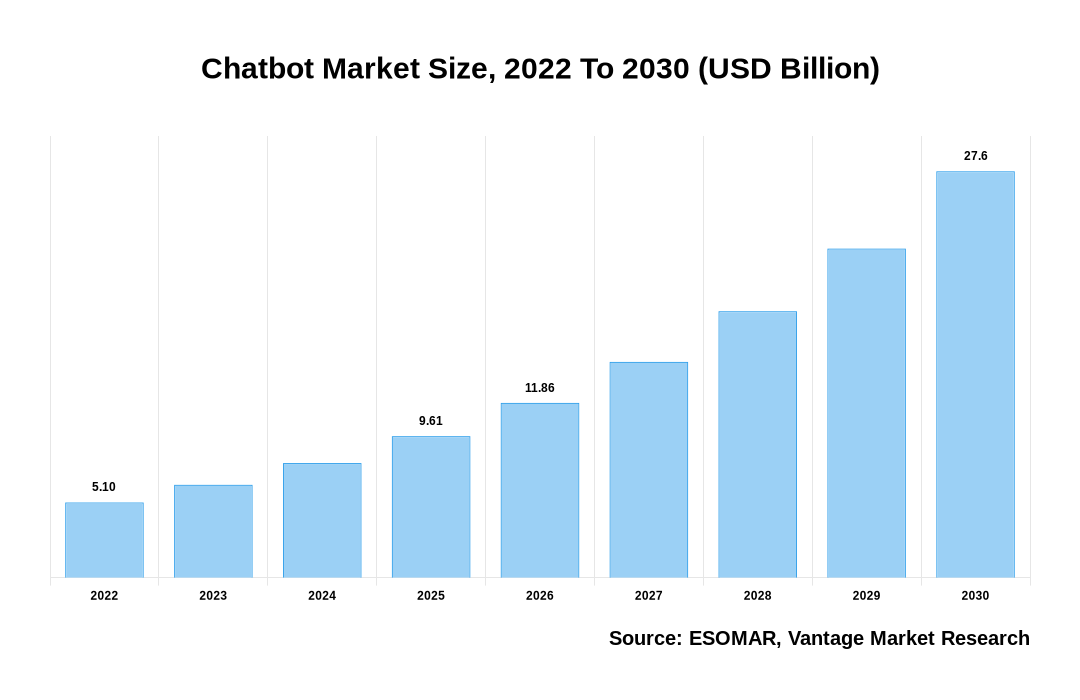Global Chatbot Market
As stated in our extensive report; the Global Chatbot Market accounted for USD 27.6 Billion by 2030.
Chatbots make use of the processing of natural language and artificial intelligence (AI) to comprehend the customer goals and offer support with minimal effort. They serve as virtual assistants for customer interactions and provide prompt and relevant answers to user inquiries. Integrating Chatbots with messenger apps, which are widely used, can increase returns on investment and enhance user experience. Additionally, messenger apps enable Chatbots to store chat histories for personalization and gain valuable insights.
The main drivers behind the adoption of Chatbots are the advancements in AI technology and the global increase in retail and e-commerce. The growing demand for a Chatbot platform that utilizes natural language processing (NLP) on social media is also a significant factor. As per Facebook, Inc., there were approximately 300,000 bots on Facebook in 2018. Companies implement messaging platforms and services to automate their business operations, make product and service recommendations, enhance marketing engagement, predict user purchasing behavior, reduce costs, and more.
Click To Get a Free Sample On the Research Study

During the forecast period, the industry is expected to grow as more SMEs offer AI bots. Numerous SMEs are creating more advanced messenger bot services for messaging apps to enhance customer experience and address customer queries more effectively. For example, in May 2018, eGain Corporation introduced Solve, a solution for Amazon Connect that utilizes Amazon Web Services (AWS) cloud infrastructure. This solution enhances the consumer experience by quickly resolving initial-level queries.
Key Factors Influencing Global Chatbot Market Growth
The growth of the global Chatbot market can be attributable to the following:
- Companies are looking for cost-effective ways to handle customer queries and provide support. Chatbots are being deployed to automate customer interactions and reduce the need for human customer service agents.
- Chatbots are getting smarter and are able to comprehend and reply to complicated questions. AI and NLP technologies enable Chatbots to learn from interactions and provide personalized and context-aware responses.
- With the increasing use of messaging apps, Chatbots have become an effective way for businesses to engage with customers. Businesses can effectively reach a wide audience by integrating Chatbots into messaging services such as WeChat, WhatsApp, Facebook Messenger, and so on.
- Chatbots are being adopted across multiple industries, including e-commerce, healthcare, banking, travel and hospitality, and more. They are used for various applications such as sales assistance, appointment scheduling, order tracking, and troubleshooting.
- With ongoing research and development in AI and NLP, Chatbots are constantly evolving with improved capabilities. This drives further adoption and growth in the market.
- Virtual assistants like Amazon Alexa, Google Assistant, and Apple Siri are driving the adoption of Chatbot technology. These virtual assistants rely on Chatbot algorithms to understand and respond to user queries.
North America Region to Express the Largest Market Growth
North America is accounted to have the most significant market growth in 2022. The demand for Chatbots is exceptionally high due to the region’s technologically advanced infrastructure, large customer base, and the presence of several major industry players. The United States and Canada have witnessed extensive adoption of Chatbots across various sectors, including retail, healthcare, banking, and e-commerce. North America businesses have recognized the benefits of Chatbots in streamlining their customer service operations, reducing costs, and enhancing customer satisfaction. As a result, many companies are investing in Chatbot development to stay competitive in their respective markets.
Furthermore, Chatbots are being utilized to automate repetitive tasks, such as answering common customer inquiries or guiding users through a website. Businesses benefit from this automation by saving time and money, which allows them to concentrate on more important duties while increasing operational effectiveness. The region’s fast-paced and digitally driven environment is conducive to adopting Chatbots. North American consumers are accustomed to digital interaction and increasingly embrace Chatbots as a convenient and efficient means of obtaining information or assistance.
Conclusion
Overall, numerous factors, such as the growing need for automation, the increasing use of mobile devices, the development of AI and NLP technologies, the rise of messaging platforms, and the COVID-19 epidemic, have contributed to the expansion of the Chatbot market. As businesses strive to provide better customer service, Chatbots are becoming integral to their customer engagement strategies, offering a seamless and efficient way to interact with customers and deliver personalized experiences.
Some of the key players in the Global Chatbot Market include [24]7.ai Inc. (U.S.), Acuvate Software (UK), Aivo (U.S.), Artificial Solutions (Sweden), Botsify Inc. (U.S.), Creative Virtual Ltd. (UK), eGain Corporation (U.S.), IBM Corporation (U.S.), Inbenta Technologies Inc. (U.S.), Next IT Corp. (U.S.) and others.
![[Market Research Reports] – Research Google News Blog | VMR.Biz](https://www.vmr.biz/wp-content/uploads/2022/12/logo-removebg-preview.png)











